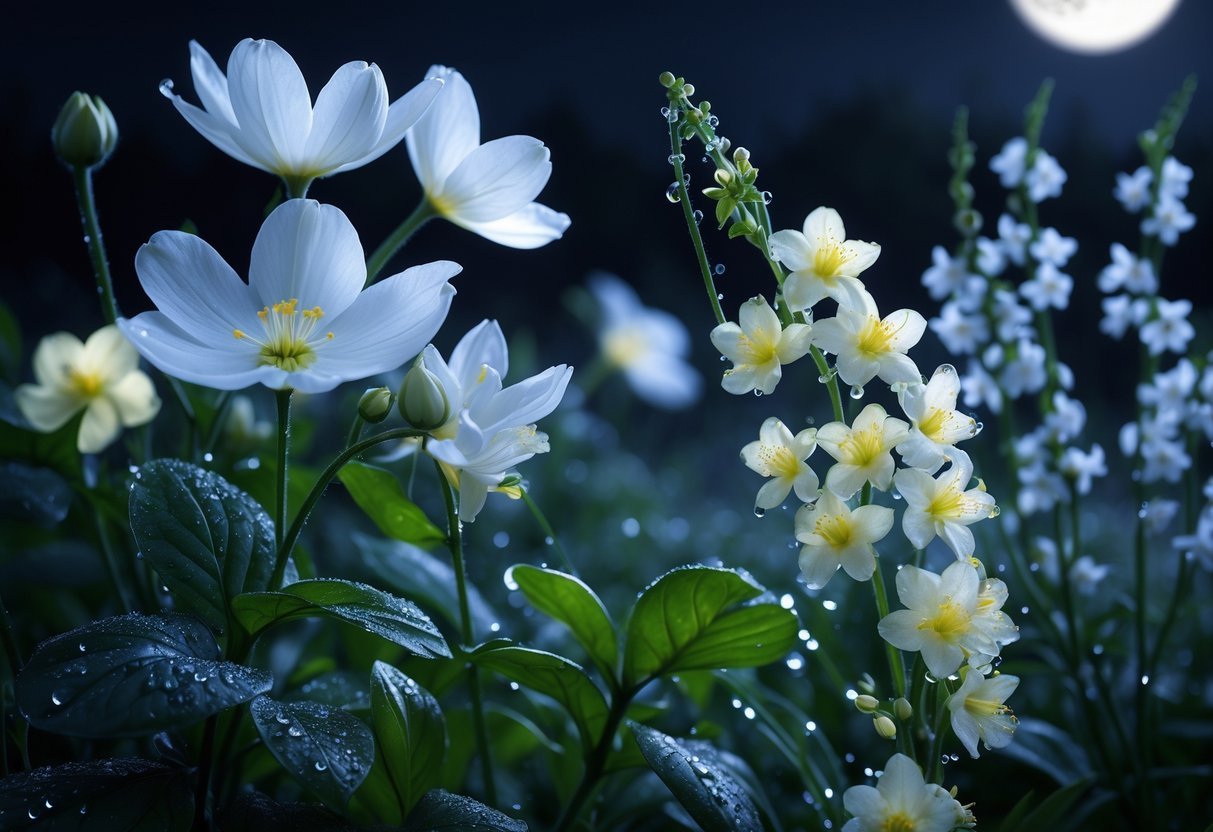Many plants release their most potent fragrances after sunset, creating a unique sensory experience for nighttime gardeners. Night-blooming plants are specially adapted to produce strong, pleasant scents that fill the air when temperatures drop and daylight fades. These plants not only enhance outdoor spaces with distinctive aromas but also bring life to gardens after dark.

Among the best-smelling night bloomers are species like Night-Blooming Jasmine, which is famous for its intense, sweet scent that perfumes the night air. Others, such as moonflowers and certain evening primroses, open their blooms after dusk, releasing fragrances designed to attract nocturnal pollinators. Their aromatic qualities make them valuable additions for anyone looking to enjoy a garden that thrives both visually and olfactively at night.
Night-blooming plants often have small but abundant flowers that open after sunset, combining beauty with function by enriching the night environment. Their presence can offer an inviting atmosphere for outdoor gatherings or quiet reflection, making them an excellent choice for enhancing evening garden enjoyment.
Key Takeways
- Night-blooming plants release the strongest scents at night.
- Many species attract nocturnal pollinators with their fragrance.
- These plants enhance nighttime garden ambiance and enjoyment.
Most Fragrant Night Blooming Plants for Scented Gardens
Night blooming plants often feature white or pale flowers with strong, distinctive scents designed to attract nocturnal pollinators. These plants release their fragrances in the evening, creating a sensory experience ideal for gardens intended to be enjoyed after dark.
Moonflower and Its Enchanting Aroma
The moonflower (Ipomoea alba) is known for its large, white, trumpet-shaped flowers that open at dusk. It produces a strong, sweet fragrance that fills the night air, making it a popular choice for moonlit gardens.
This vine thrives in warm climates and grows quickly, often covering trellises or fences. Its scent is subtle at first but intensifies as the evening progresses, offering a calming, almost magical ambiance. The moonflower’s scent is sometimes described as slightly citrusy and fresh, complementing the pure white bloom that stands out in low light.
Tuberose: The Essence of Intoxicating Fragrance
Tuberose (Polianthes tuberosa) carries one of the most potent night fragrances among flowering plants. Its waxy, white flowers bloom late in the day and release a rich, heady aroma that intensifies during the night.
This plant is widely prized for its use in perfumery due to its complex, intoxicating scent which blends floral and creamy notes. It grows as a bulb and requires well-drained soil and full sun. Gardeners value tuberose not only for nightlife but also its dramatic floral clusters, which can be used fresh or dried for scent enhancement.
Night Phlox and Night-Scented Stock
Night Phlox (Zaluzianskya ovata) and Night-Scented Stock (Matthiola longipetala) are popular for their consistent evening fragrance and smaller, delicate flowers.
Night phlox displays star-shaped white or pale blooms that emit a strong, lemony fragrance that is fresh and light. It is a compact plant, ideal for borders or containers.
Night-scented stock also produces white to creamy flowers that bloom in the evening. Its scent is sweet with a spicy hint, making it a subtle but noticeable addition to night gardens. Both plants are easy to grow and suited for temperate climates.
Jasmine, Gardenia, and Honeysuckle Varieties
Several varieties of Jasmine, Gardenia, and Honeysuckle are renowned for their intense night-time fragrance. Jasmine flowers, often white or pale yellow, release a rich, sweet perfume after sunset, heavily influencing evening garden scent profiles.
Gardenias offer creamy white blooms with a velvety appearance and provide a deep, intoxicating scent that lingers well into the night. They prefer warm, moist environments and make excellent container or garden shrubs.
Honeysuckle varieties, with tubular flowers in shades of white and yellow, produce a sweet, heady aroma that attracts moths. Their scent often carries a subtly fruity or lemony note, adding variety to a scented garden’s fragrance palette. These plants typically require support structures and part sun exposure.
Unique Features and Garden Benefits of Night Bloomers
Night-blooming plants offer distinctive shapes and fragrances that enhance gardens after dark. Their adaptations not only appeal visually but also serve ecological functions by attracting specialized pollinators. These traits make night gardens both beautiful and biologically active spaces.
Trumpet-Shaped Flowers and Their Nighttime Appeal
Many night bloomers feature trumpet-shaped flowers, a shape that promotes fragrance diffusion and easy access for pollinators. Plants like angel’s trumpet (Brugmansia) and datura showcase large, pendulous blooms that release a stronger scent at night.
The trumpet shape often correlates with white or pale colors, improving visibility in low light. These flowers commonly emit sweet or spicy fragrances, which increase after dusk, creating a sensory highlight in the garden. The form and scent attract attention and define the nocturnal garden’s aesthetic.
Attracting Nocturnal Pollinators
Night bloomers have evolved to attract specific nocturnal pollinators such as moths and bats. Flowers like cestrum nocturnum and evening primrose (Oenothera biennis) release their fragrance at night to guide these pollinators.
These plants rely on scent, flower shape, and color to maximize pollination success when daytime pollinators are inactive. This interaction supports biodiversity and ensures seed production. Attracting nocturnal pollinators also benefits the broader garden ecosystem by encouraging natural pest control and enhancing plant diversity.
Creating a Night Garden with Color and Scent
A successful night garden balances visual appeal and aroma. Using plants like four o’clock (Mirabilis jalapa) and flowering tobacco (Nicotiana alata) adds bursts of pastel hues that contrast with dark surroundings.
Combining fragrant blooms such as hesperis matronalis (pinks) with varied flower shapes enriches the sensory experience. These plants continue blooming after sunset, producing an environment ideal for relaxation or evening enjoyment while filling the air with pleasant scents. Strategic planting of these species can transform any garden into a vibrant nocturnal retreat.




